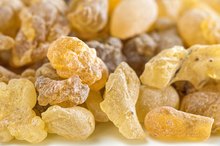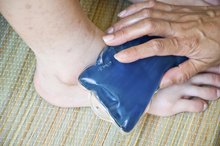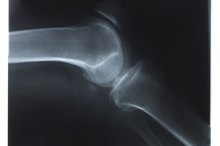Pain in My Right Big Toe
Your foot is a complex structure consisting of muscles, tendons and other tissues, as well as over 26 bones, including 19 toe bones or phalanges. Everyday weight-bearing activities such as standing and walking, plus your weight and recreational activities, place tremendous stress on your feet. As a result, various structures are at high risk for injury, some of which can cause pain in your right big toe.
Hallux Rigidus
This disorder, also known as “stiff big toe” targets the joint at the base of your big toe. “Hallux” means “big toe” and “rigidus” means that your toe is stiff or rigid 2. In the early stages when there’s only mild stiffness, the condition is known as “hallux limitus.” It’s a form of degenerative arthritis and may be due factors such as structural abnormalities or overuse. You’ll experience pain and stiffness during activities such as walking or standing and pain becomes worse when the weather is cold. Symptoms also include inflammation and swelling.
- This disorder, also known as “stiff big toe” targets the joint at the base of your big toe.
- “ You’ll experience pain and stiffness during activities such as walking or standing and pain becomes worse when the weather is cold.
Gout
Normal Range of Motion for the Great Toe
Learn More
This form of arthritis develops when you have too much uric acid in your body. The uric acid accumulates and forms crystals that cause joint pain, particularly at the base of your big toe. Pain can be excruciating, responding to even a light touch. Men are more at risk for gout, but women’s risk increases after menopause. Additional symptoms to watch for include redness and swelling of the joint at the base of your big toe.
- This form of arthritis develops when you have too much uric acid in your body.
- Additional symptoms to watch for include redness and swelling of the joint at the base of your big toe.
Big Toe Tendonitis
Tendons are tissues that connect muscles to bone. The tendons that run across the top of your feet to your big toe and other toes help to pull your feet upward and downward. When these muscles become overstressed and inflamed you develop a condition called tendonitis, which causes pain and in some cases, swelling. The tendon that runs to the big toe is particularly susceptible to tendonitis and pain. It’s primarily due to excessive tightness in your calf muscles or too much stress during exercise or when the arch of your foot falls.
- Tendons are tissues that connect muscles to bone.
- The tendons that run across the top of your feet to your big toe and other toes help to pull your feet upward and downward.
Treatment
Nutrition for Shin Splints
Learn More
Because these conditions share some symptoms, such as pain, inflammation and reduced function, it’s best to consult your doctor to properly diagnose any persistent pain in your big right toe. Treatment for these conditions varies, but one common remedy is non-steroidal anti-inflammatory medications, such as ibuprofen, to relieve pain and inflammation. R.I.C.E. — resting your foot, applying ice and compression and elevating your foot -- can relieve pain and swelling due to tendonitis or Hallux rigidus 2. Therapeutic exercises can help to treat hallux rigidus and tendonitis 2. For gout, your doctor may also recommend medications such as colchicine or allopurinol to lower uric acid. Once your doctor diagnoses your condition, he can create the best treatment plan for you.
- Because these conditions share some symptoms, such as pain, inflammation and reduced function, it’s best to consult your doctor to properly diagnose any persistent pain in your big right toe.
- For gout, your doctor may also recommend medications such as colchicine or allopurinol to lower uric acid.
Related Articles
References
- Foot Health Facts: Toe and Metatarsal Fractures (Broken Toes)
- Foot Health Facts: Hallux Rigidus
- "American Family Physician"; Gout – What You Should Know; Sept. 15, 2007
- National Institute of Musculoskeletal and Arthritis and Skin Diseases: Gout
- Yale Medical Group: The Best Ways to Treat, Prevent Tendonitis
- Anderson MR, Ho BS, Baumhauer JF. Current Concepts Review: Hallux Rigidus. Foot & Ankle Orthopaedics. 2018;3(2):247301141876446. doi:10.1177/2473011418764461
- Beeson P, Phillips C, Corr S, Ribbans W. Hallux rigidus: A cross-sectional study to evaluate clinical parameters. The Foot. 2009;19(2):80-92. doi:10.1016/j.foot.2008.12.001
- Lam A, Chan JJ, Surace MF, Vulcano E. Hallux rigidus: How do I approach it? World Journal of Orthopedics. 2017;8(5):364. doi:10.5312/wjo.v8.i5.364
- Dulgeroglu, T., and H. Metineren. Treatment of End-Stage Hallux Rigidus Using Total Joint Arthroplasty: A Short-Term Clinical Study. Journal of Foot and Ankle Surgery. 2017. 56(5):1047-1051.
- Larn, A., Chan, J., Surace, M., and E. Vulcano. Hallux Rigidus: How Do I Approach It?. World Journal of Orthopedics. 8(5):364-371.
Writer Bio
Kay Uzoma has been writing professionally since 1999. Her work has appeared in "Reader’s Digest," "Balance," pharmaceutical and natural health newsletters and on websites such as QualityHealth.com. She is a former editor for a national Canadian magazine and holds a Bachelor of Arts in political science from York University.









